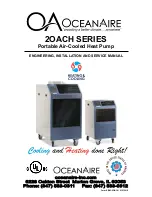
9
5. Mounting
5.1 Connection of Water Piping
The nominal pipe widths of the field-installed sanitary installations must be determined on the basis of the
available water pressure and the expected pressure drops within the piping system.
The water-side installation has to be executed in compliance with DIN 1988 (see appendix – in the case of
excessive water pipe pressure, a pressure relief valve is to be provided, among other things !)
The water pipes may be of the rigid or flexible type. The materials used in the piping system must be chemically
compatible in order to prevent any corrosion damage (see section Commissioning).
Caution!
When installing the pipework on the customer's site, any contamination of the piping
system must be avoided (pipes may have to be flushed prior to the connection of the
HPWH)!
5.2 Connection of condensate line
The condensate hose is passed through the foil-faced insulation jacket on the rear of the unit. The condensate
hose must be routed in such a way that any condensate which may form can drain without obstruction.
At the end of the condensate hose a sealing lip valve (that opens without pressure) is provided which must also
be relocated when the condensate hose is shortened (valve can be easily removed and reinstalled). In particular,
this valve is required if rather long air hoses are installed on the unit, or an upstream filter is installed on the
exhaust air side. The condensate has to be drained into a siphon (or, as an alternative, into a collecting vessel
which would have to be emptied regularly (see also Maintenance notice under 7.1).
5.3 Electrical
Connection
The HPWH is pre-wired, ready for connection, the power is supplied via the mains cable connected to a wall outlet
with earthing contact (~230 V, 50 Hz). This outlet must be accessible also after the installation has been
completed.
For the connection of the remote control device, a separate cable ( 6-pole with a minimum wire cross-section of
0.75 mm
2
and max. outside diameter of 13 mm) must be inserted into the unit through the screwed cable gland
provided for this purpose, which also serves as a strain relief.
For the control of external devices for the supplementary heat source (applies only to HPWH with internal heat
exchanger), a separate cable must be fed into the unit as well. The terminal (X1 – 9/10/PE) with a potential-free
contact for the control (ON/OFF) of the external ancillary equipment (pump, solenoid valve, etc.) is located on the
partition inside the unit. The external supply leads must be fed through the partition through the free cable bushing
provided for this purpose. It is necessary to remove the plastic hood of the HPWH to make these electrical
connections.
External immersion heater control
As an option, it is possible to configure the immersion heater in such a way that in addition to the activation by the
"immersion heater" switch on the operating panel on the HPWH it is also possible to activate the electric heating
element remotely (e.g. by using a timer). A potential-free contact on the external switchgear must be available for
this connection; in addition, another wire (min. 2 x 1.0 mm
2
/ max. outside dia. 10 mm) must be introduced into the
unit and clamped to terminals 7 and 8 of terminal strip X1.
9 + 10 Connection for the control of
external ancillary equipment
1
1
/
3(
3(
1
1
/
3(
3(
43
<
;
:
9
8
7
6
43
<
;
:
9
8
7
6
X1
5
4
5
4
1 – 6 Connection of remote control
connecting lead
7 + 8 Connection for external
immersion heater activation (option)
Fig. 5 : Terminals on partition wall










































